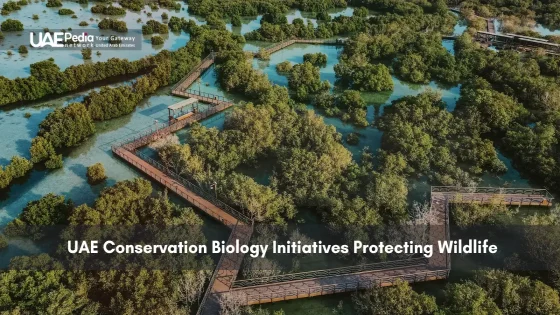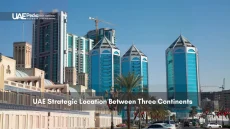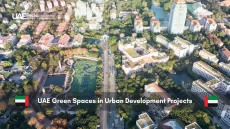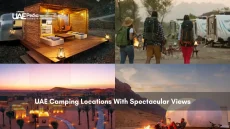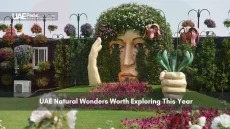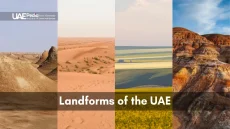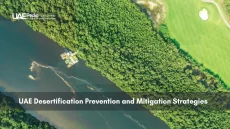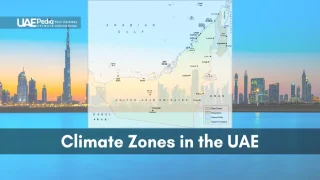What if we told you over 14% of this nation’s terrain isn’t skyscrapers or highways—but protected land humming with endangered species? While global headlines often spotlight the UAE’s urban marvels, a quieter revolution unfolds where desert foxes dart through diverse ecosystems and hawksbill turtles nest on guarded shores.
Since 2015, collaborative efforts between local experts and global organizations have turned ambitious resolutions into action. Take the Arabian oryx—once nearly extinct, now roaming free thanks to breeding programs. Or the ‘Beautiful in the Wild’ campaign that shifted public perception about keeping exotic animals as pets. These stories reveal a pattern: blending Bedouin stewardship traditions with cutting-edge science.
The country’s national biodiversity strategy doesn’t just protect species—it reimagines coexistence. Mangrove forests expand to capture carbon while flamingos feed. Solar-powered desalination plants quench human needs without draining natural aquifers. Even date palms get DNA profiling to preserve genetic diversity.
- Behind-the-scenes look at initiatives saving species from scorpions to sea cows
- How 43 protected areas create wildlife corridors across mountains and coasts
- Practical ways travelers and residents can support these efforts responsibly
Exploring UAE Conservation Biology’s Global Role
Picture this: customs officers at Dubai International Airport spot suspicious luggage. Instead of designer knockoffs, they uncover rhino horns disguised as decor—a real 2023 interception made possible by global workshops sharpening detection skills. This isn’t lone hero work. It’s how border control meets biodiversity through alliances spanning 18 countries.
Border Checks with a Conservation Twist
Ever wondered how illegal wildlife parts get flagged mid-transit? The answer lies in partnerships like the UAE’s work with CITES and TRAFFIC. Since signing the Doha Declaration, authorities have trained over 1,200 airline staff to recognize trafficking tricks—think reptile eggs tucked into snack boxes or songbirds sedated in hair curlers.
From Conference Rooms to Coastlines
Global resolutions don’t just gather dust here. After the 2015 UN agreement on endangered species, the government redesigned its protected areas strategy using data from Mongolian snow leopard trackers and Brazilian parrot rehab centers. The result? Wildlife corridors that now stretch across 43 reserves, sheltering everything from Arabian leopards to hawksbill turtles.
Customs teams recently shared a win: intercepting 154kg of smuggled shark fins bound for restaurants, thanks to a tip from Southeast Asian conservationists. As one officer told us, “It’s like we’ve got eyes in every jungle now.” Next up: how solar-powered tech helps rangers patrol these vast wild spaces.
Innovative Approaches in Species Protection and Habitat Restoration
Imagine rangers using drones shaped like falcons to monitor nests while Bedouin trackers share ancestral knowledge of desert water sources. This fusion defines modern species protection here—where AI analyzes turtle migration patterns and elders teach how to read sand dunes like ancient maps.
Guardians of the Land: Parks That Tell Stories
Jebel Hafeet National Park isn’t just a mountain—it’s a living archive. Its 400+ plant species thrive alongside Nubian ibex herds, protected by smart sensors that alert rangers to poachers. Nearby, Al Wathba Wetland Reserve proves salt flats can sparkle with life: 4,000 flamingos now nest where camels once drank.
Second Chances for Species on the Edge
The Arabian oryx’s comeback reads like a thriller. From 18 captive animals in 1962 to 1,200 roaming free today, their GPS-collared herds map climate-resilient routes. Meanwhile, hawksbill turtle hatchlings get VIP treatment—beach patrols shield nests, while satellite tags reveal their oceanic highways.
Stitching Ecosystems Back Together
Abu Dhabi’s mangrove warriors have planted 15 million trees since 2020. These carbon-absorbing forests now shelter 60+ bird species and buffer coastlines. Divers join the fight too—coral ‘nurseries’ grow heat-resistant reefs, with 12,000 fragments transplanted last year alone. “It’s not just saving nature,” says marine biologist Layla Al-Mansoori. “We’re rebuilding life support systems.”
From mountain peaks to sea floors, these efforts prove habitats heal when given half a chance. The secret? Treating each landscape as a puzzle where tech, tradition, and tenacity interlock.
Legal Frameworks, Public Awareness, and Sustainable Development
Ever wondered what keeps desert ecosystems thriving alongside skyscrapers? Strong laws and passionate communities form the backbone of wildlife protection here. Let’s unpack how rules and rallies create real change.
Laws That Live and Breathe
Federal Law No. 24 of 1999 isn’t just paperwork—it’s a shield for natural heritage. This law bans harmful practices while mandating annual checks on protected areas. Think of it as a nutrition label for ecosystems: rangers measure water quality, species health, and habitat changes.
| Initiative | Impact | Partners |
|---|---|---|
| National Environmental Education Strategy | 300+ schools teaching wildlife ethics | Ministry of Education |
| Corporate Sustainability Pledge | 42% reduction in coastal pollution | Major tourism companies |
| Community Patrol Program | 1,200 volunteers monitoring reserves | Local municipalities |
When Communities Take the Wheel
The ‘Beautiful in the Wild’ campaign flipped the script on exotic pets. Now, families track endangered species through citizen science apps instead. Public awareness workshops teach kids to build birdhouses from recycled materials—proof that sustainable development starts small.
Looking ahead? The UAE Environment 2030 plan weaves climate goals into urban growth. As conservation officer Amal Al-Haddad says, “Our laws light the path, but people’s hearts fuel the journey.” From beach cleanups to solar-powered farms, every action stitches resilience into the land’s fabric.
Last year, 89% of residents could name three local endangered species—up from 37% in 2015. That’s the power of turning legal frameworks into living traditions. When generations grow up seeing mangroves as neighbors rather than scenery, protection becomes second nature.
Celebrating Progress and Envisioning Future Conservation
Picture sand dunes where Arabian oryx herds now outnumber oil rigs—a testament to decades of grit. Over 50% of the country’s land now shelters protected areas, from mountain sanctuaries to coral-rich seas. Take Abu Dhabi’s mangrove surge: 15 million trees planted since 2020, creating nurseries for 60+ bird species while buffering cities from storms.
Success stories abound. The Arabian oryx, once down to 18 individuals, now thrives with 1,200 roaming free. Coastal patrols boosted hawksbill turtle nests by 63% since 2018. Even desert foxes rebound through community-led tracking programs blending tech and tradition.
Looking ahead? Solar-powered ranger stations. AI predicting climate change impacts on migration routes. Cities where skyscrapers share zip codes with flamingo colonies. Already, 89% of residents recognize local endangered species—proof that awareness fuels action.
Your role? Join beach cleanups. Choose eco-tours. Report wildlife sightings through citizen apps. Every click, step, or shared story stitches resilience into our planet’s fabric. Because when deserts bloom and reefs pulse with life, we all win.
Sir Bani Yas Island’s Arabian Wildlife Park shelters cheetahs and oryx, while Dubai Desert Conservation Reserve preserves sand gazelles. These spaces balance tourism with habitat restoration—proof that development and nature can thrive together.
Collaborations like the Abu Dhabi Declaration tackle illegal trafficking through CITES enforcement. The country also funds anti-poaching tech in Africa and shares satellite tracking data to protect migratory birds like the houbara bustard.
Absolutely! Abu Dhabi’s Jubail Mangrove Park traps carbon 4x faster than rainforests. Over 43,000 hectares have been restored since 2020—a natural shield against rising seas and a nursery for fish populations.
Federal Law 24 bans hunting endangered animals, while the National Biodiversity Strategy 2021–2030 prioritizes habitat corridors. Fines up to 500,000 AED deter harm to hawksbill turtles or dugongs in protected marine zones.
Choose ecotours like Jebel Ali Wetland kayaking or Al Hefaiyah Mountain Conservation Centre visits. Skip single-use plastics, respect marked trails, and report wildlife sightings through apps like the EAD’s “Abu Dhabi Nature” platform.
Captive breeding saved the Arabian oryx from extinction—now 1,000 roam freely. Sharjah’s Breeding Centre for Endangered Arabian Wildlife uses genetic research to reintroduce sand cats and lappet-faced vultures into rewilded landscapes.
